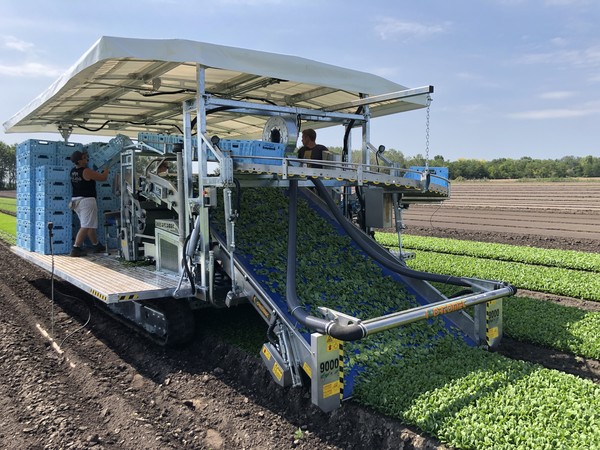
Machinery for harvesting fourth gamma salads
The broad appreciation that fourth gamma products have gained among consumers has led to the increasing development of this supply chain, which has encouraged the development of specific harvesting machinery, including electrically driven
The long-established popularity of ready-to-eat bagged salads has long consolidated a rather important role in large-scale retailers' fruit and vegetable turnover.
Unlike head vegetables, which are usually grown in the open field, slicing salads are frequently grown in protected arrangements, greenhouses or tunnels. In fact, controlled climatic conditions lead to faster crop growth, so more production cycles are carried out throughout the season. Besides reducing the danger of waterlogging, which could compromise the root systems of plants, the light and skeleton-free soils characterizing greenhouses undoubtedly facilitate planting and harvesting. Therefore, scatter seeding is carried out on adequately prepared and leveled soil. The cultivated area accounts for almost the entire greenhouse area, excluding the traffic lanes for car traffic. Once they reach 10 to 12 cm in height, the salad greens are harvested by mowing, cutting off the leaves with a clean razor-sharp cut.
Harvesting facilitating machinery
Trailed harvesters must be coupled to the tractor, which mechanically and/or hydraulically provides the power to drive them. However, there is a growing supply of self-propelled models powered by diesel engines of about 50 Hp, with hydrostatic type forward motion. Alternatively, the powertrain is electric and battery-powered; this is ideal for cultivation in sheltered set-ups because there are no exhaust fumes that harm operators and plants. The battery pack, usually placed ventrally to provide excellent stability, is often housed on a cart to facilitate its removal and/or replacement.
These batteries power one or more electric engines directly coupled to the propulsion components, which may consist of tires, usually of narrow sections, or tracks, more frequently made of rubber. The chassis is set up so that the track width can be varied to adapt the machine to the planting pattern and size of the greenhouse. The ground clearance varies depending on the models, ranging from 20 to 30 to 35 cm.
Two working areas are distinguished on the machine: the cutting and product conveying area, which consists of a cutter bar and an elevator belt, and the following area for operators to sort and clean. The area with the controls is located in the side-front area to ensure the best view of the cutting unit.
Cutting devices and product transfer
Cutting is carried out by a cutter bar, with oscillation frequency adjustable according to the crop to be harvested and the forward speed. The working width can vary from about 100 to over 200 cm. The cutting height can be hydraulically set within a given range and controlled by electronic sensors. Handling the cutting organ is very important, as it is closely related to the species to be harvested: It also affects the choice of the most suitable harvester model. For instance, lamb's lettuce is cut as low as 1-2 mm below the soil surface, while lettuce and spinach are mowed 1-2 cm high. Some models can be equipped with a small-diameter reel to facilitate the cutting and conveying the cut material. The conveying element is a plastic elevator belt, which can be either a continuous surface (smooth or embossed, in the latter case, to transfer the product better) or perforated mesh (to allow separation of the product from soil residues).
Devices for facilitating manual intervention
From a physical point of view, salad greens are remarkably perishable as they are very sensitive to impact and/or compression. Hence, the final stage of harvesting involves the intervention of some operators who, thanks in part to the help of some moving belts, manually lay down the product in boxes located at the edge of the machine. In larger models, such as Ortomec's SVC365, for example, the elevator belt transports the product to the rear of the machine. There, two movable belts concentrate the product in a single area to make it easier for operators to place it in the bins.
Facilitating equipment
Whatever the motorization, many IV salad harvesters can be equipped with optional extras to improve onboard operation. Particularly for aromatic plants, the possibility of tying the product in bunches directly on the machine is interesting. It is also possible to mount a pair of arms to deposit the product-filled bins on the ground behind the machine so as to keep the platform where the operators are stationed clear. Lastly, for models used for open-field harvesting, shade nets are available to shelter workers from the intense sunlight typical of the summer period.
The fourth range
The range of vegetables, fruits and vegetables is divided into 5 ranges, distinct according to the technologies and manufacturing processes applied to the product, from harvest to final sale.
The first range is for traditional fresh fruits and vegetables, while the second is for canned fruits and vegetables offered in jars; the third includes frozen fruits and vegetables, and the fourth is for fresh, washed, packaged, and ready-to-eat fruits and vegetables. Finally, the fifth range includes cooked and reconstituted fruits and vegetables, packaged and ready-to-eat.
Hence, bagged salads and ready-to-eat vegetables, such as stir-fry and vegetable soup, are specifically part of the fourth range. In this case, as soon as possible after harvesting, it is necessary to: select the products, sort them, remove unwanted parts and/or any foreign bodies (e.g., insects), clean, chop (in the case of processed vegetables), wash and dry the material. Finally, packaging follows, in bags or specific containers, also with the creation of a controlled or modified atmosphere inside them.
Machinery for harvesting salad greens in open fields
In the open field, salad greens are harvested in a similar way as in protected set-ups. The only difference is that the models used are significantly larger and are almost exclusively equipped with diesel engines and hydrostatic transmissions. The working width almost always exceeds 2 m, up to more than 3.6 m in Ortomec's SVC365 model. Often the engine power is also adequate to move a trailer to load the bins simultaneously, so the harvest yard highlights a different solution for conveying the cut produce.
With such large harvesting heads, it is necessary to resort to mobile transverse belts, which convey the salad greens to a single concentration area. Again, the harvested material can be placed manually inside the boxes or, in larger models, can be stored with the help of dedicated conveyor belts or gooseneck systems, always, however, under the supervision of the workers.








